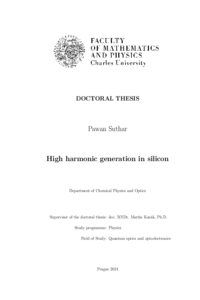High harmonic generation in silicon
Generace vysokých harmonických frekvencí v křemíku
dizertační práce (OBHÁJENO)

Zobrazit/
Trvalý odkaz
http://hdl.handle.net/20.500.11956/195345Identifikátory
SIS: 212562
Kolekce
- Kvalifikační práce [11326]
Autor
Vedoucí práce
Konzultant práce
Malý, Petr
Trojánek, František
Oponent práce
Bulgakova, Nadezhda
Němec, Hynek
Fakulta / součást
Matematicko-fyzikální fakulta
Obor
Kvantová optika a optoelektronika
Katedra / ústav / klinika
Katedra chemické fyziky a optiky
Datum obhajoby
27. 9. 2024
Nakladatel
Univerzita Karlova, Matematicko-fyzikální fakultaJazyk
Angličtina
Známka
Prospěl/a
Klíčová slova (česky)
Vysoká harmonická generace|nelineární optika|HHG v křemíkuKlíčová slova (anglicky)
High harmonic generation|Nonlinear optics|HHG in siliconGenerace vysokých harmonických frekvencí (HHG, z angl. high harmonic generation) v pevných látkách vzbudila značný zájem díky svému potenciálu pro vývoj nových svě- telných zdrojů a studium ultrarychlé dynamiky elektronů. V této práci se zaměřujeme na výzkum HHG v krystalickém křemíku s cílem zlepšit naše porozumění mechanismům ve- doucím ke generaci koherentních vysokoenergetických fotonů. Konkrétně jsme se zaměřili na experimenty, které nám umožňují vztáhnout spektra vysokých harmonických frekvencí generovaná nerezonančními vysoce intenzivními laserovými pulsy k pásové struktuře stu- dovaného materiálu, prokázat roli ultrarychlého rozfázování elektronů během procesu HHG a řídit amplitudu a fázi generovaných vysokoenergetických fotonů změnami vlast- ností budících infračervených pulzů. Porovnání výsledků s numerickými simulacemi a analytickými modely nám dovolilo studovat vliv Van Hove singularit ve sdružené hustotě stavů na HHG či vliv rozložení hybnosti přeexcitovaných nosičů na vnitropásovou ge- neraci. Výsledky práce přinášejí nové poznatky o interakci silných nerezonančních pulzů s pevnými látkami a o koherentní nelineárně-optické odezvě materiálů v režimu silného pole.
High harmonic generation (HHG) in solids has drawn significant interest for its po- tential in developing novel light sources and studying ultrafast electron dynamics. In this work, we focus on the investigation of HHG in crystalline silicon to improve our under- standing of the mechanisms leading to the generation of coherent high-energy photons. Specifically, we focused on experiments that allow us to relate the high harmonic spectra generated by non-resonant high-intensity laser pulses to the band structure of the studied material, demonstrate the role of ultrafast electron dephasing in the HHG process, and control the amplitude and phase of the generated high-energy photons by changing the properties of the driving infrared pulses. Comparing the results of the experiments with numerical simulations and analytical models allowed us to study the effect of Van Hove singularities in the joint density of states on HHG or the effect of the momentum distri- bution of pre-excited carriers on intraband generation. The findings of this thesis provide new insights into the interaction of strong non-resonant pulses with condensed matter and the coherent non-linear optical response of materials in the strong field regime.
